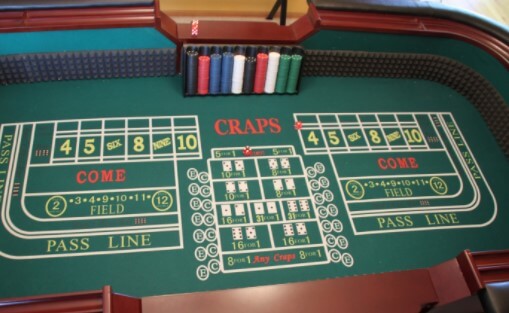Craps Strategy to the ideal Bettor starts with learning appropriate strategy if you would like to match the 98 percent of rollers who bet with the shooter. A proper Bettor is a player that wagers with the shooter, trusting that s/he will win the roster.
A little 2% of players called Wrong Bettors wager against the shooter, trusting that s/he will eliminate the roll. This sort of player is generally not welcome at the table.
Buying In
Buy in at a five-dollar minimal table. (There is usually $5 tables available during non-peak hours). Choose a table that provides at least double chances because the odds bet pays off incorrect odds, no House Edge.
It’s prudent to buy in for at least 20X the table minimal as you wish at least three numbers are working for you during every roll. When you’re ready to play, put your cash on the table: request 20 five-dollar chips and 20 one-dollar chips. ($120 total).
There are concave grooves on the edge of the table for racking your chips. Rack your five-dollar chips and put ten one-dollar chips on each side. Keep a watchful eye on your chips amidst the roars of the crowd. Occasionally hunters circle the crap tables, hoping that this game’s excitement will divert the players long enough to swipe their chips.
Right Bettor Strategy
Once the dealer announces a new game will begin yelling”Comin’ out,” set a five-dollar chip on the Pass Line. Also, put three one-dollar chips on the table toward the dealer and say, “three-way craps.” He’ll put 1 dollar each on the 2, 3, and 12. This will keep you from the game on the come-out roster with the following possibilities:
When the shooter rolls:
- 7 or 11 – you win 5, shed 3
- 2 or 12 – you shed 7, win 30
- 3 – you shed 7, win 15
- 4, 5, 6, or 8, 9, 10 – you lose 3 (the five bucks stay on the pass line.) 4 through 6 and 8 through 10 are called point numbers.
By way of instance, if a four is rolled, your five bucks are still active. The 4 becomes the point number. For you to win your bet, the four needs to be rolled again before a 7. No other number matters, however long it takes.
The Odds Bet
Once the point is established, always take double odds with your point number. Place ten bucks behind your $5 Pass Line bet for 2X odds. If you win, the payout is in true odds. There are three ways to win with four as a stage number: 1, 3; 3, 1 or 2, two.
It can be lost in many ways with a seven: 4, 3; 5, 2; 6, 1 – or 3,4; 5; 1,6. You can put it differently; there’s a 2:1 payoff when the four comes up before the seven. If that’s the case, you will win twenty bucks: five bucks for your Pass Line bet and twenty bucks for your odds bet. Here are the true odds for all the stage numbers:
- Point Amount True Odds
- 4 and 10 – 2 to 1
- 5 and 9 – 3 to 2
- 6 and 8 – 6 to 5
Place Betting
Once you’ve put your odds bet, let us assume the point is 4, place twelve bucks on the table, and let the dealer PositionPosition the 8 and 6. The dealer will place six dollars on every number. Every time a 6 or 8 are rolled before a seven or your 4, you will be paid seven bucks. While the place bets aren’t correct odds, it’s still a fantastic payout. You might want to press up one time (double the wager ) to have twelve bucks on every number.
If 6 or 8 is the stage number, keep away from the place bet on that number and put twelve bucks on the opposite number.
The aim is to invite Lady Luck to drop her 6’s and 8’s before your point number is made or the dreaded seven is rolled.
Remember, the 6 and 8 can be rolled over any other number except the 7. This is the reason the strategy can be useful to you.
While there are quite a few different bets on the layout called propositions (prop) stakes, these are just one roll only bets with an extremely higher casino advantage. Could you stay away from them?
Many players prevent the casino game of craps initially since the big oval-shaped table with numerous betting options seems a little intimidating to table game players. Craps is really easy to learn and fun to play, and here is how:
Start in a five-dollar minimum table. You’ll usually see them during non-peak hours. When the button on the table is in the OFF position, place your cash on the table, and ask the dealer for $5 chips. You will notice seasoned players making a variety of bets. Among the best-known bets is the PASS LINE. Place a processor (s) in that place before you. When you hear the trader shout “COMING OUT,” that is when the excitement begins, and the designated SHOOTER will throw two dice. Here are the wagering options:
Pass Line if on the first roll a 7 or 11 comes out roll, you win even money. If a 2, 3, or 12 seem, you lose. Any other number, 5, 4, 6, 8, 9, or 10, becomes your POINT. A dealer will indicate the point number with the ON button showing a game in advance. For one to win, the shooter must roll the point number before he or she rolls a 7. If a seven appears before the stage, the house wins. No other numbers matter on this bet, however long it takes. To end the game, you must get a seven or a point.
Odds Bet
This is a bet every pass line bettor should take advantage of because it pays off in TRUE ODDS and has no house advantage. If a point number is rolled, you’ll have the chance to take odds on this bet by placing another bet behind your pass line wager. Most casinos allow doubling odds bet. By way of instance, let’s say 4 is your point. There are three ways to win with the 4: 1 and 3, 2 and 2, or 3 and 1. You can lose six ways with a seven: 3 and 4, 5 and 2, 1 and 6, 3 and 4, 5 and 2, 6, and 1. Thus, 6/3 is two to a payout. Your $10 double wager will earn you $20, and your pass line bet if you win.
Do Not Pass
Very few players use this option as a strategy. The exact opposite of the passing Line works. You’re probably betting that the shooter will narrow down the list. A wager on the do not pass Line will win if the come-out shooter rolls a 2 or 3, push (no win/no reduction ) with 12, lose if a 7 or 11 is rolled. Odds bets can be found. However, your odds of winning are more significant than losing, so you’ve got to lay the odds rather than taking them. If a point is rolled, for example, 4, then you win if a seven is rolled first. This time 3-6 is a one to 2 payouts so that you would need to set up $20 to win $10 and also the do not pass wager.
On average, only 2% of players bet seriously with the do not pass, AKA wrong bettor. You won’t have many friends at the table when gambling wrong.
Come Bets
Come bets work precisely the same manner as a pass line bet, but it is realized after a point is fixed. Wins 7 or 11; Loses: 2-3-12. Other numbers become your come to an end and must be rolled before a 7 for you to win. You could even take correct odds on your come the moment following the dealer moves your processor (s) into the suitable number box. This bet is independent of the pass line bet, and you come the issue might be other than your pass line point. Thus, if the shooter makes their pass line stage, the game ends, but you reach the point wagers stay active. If a seven is rolled during the following come out roll, you drop the come bet, but your chances are returned to you.
Don’t Come Bets
This strategy is used in the same way as ado not pass bet after a point is established. You might also lay correct odds. You would like the 7 to be rolled before they do not come to an end. Here’s the one major exception on a do not come bet: if the shooter wins their pass line bet, and they do not reach the point is created on the following come out roll, you do not just lose your chance, but your odds bet also.
Place Bets
A bet on one or more point numbers (4, 5, 6, 8, 9, and 10); The bet(s) win if the number repeats until a seven is rolled and lose if a seven appears first. Payoffs are 6, 8- pay 7/6, 5, 9- pay 7/5, 4, and 10- cover 9/5.
Buy and Lay Bets
A buy bet is just like a place bet, except you pay a five percent commission to the house if you make a bet, but you’re born incorrect odds if you win. Payoffs are 6, 8 pays 6/5, 5, 9 pays 3/2, 4, and 10 covers 2/1. A lay bet is the precise opposite of the buy bet. You have to wager more to acquire less because your odds of winning are more significant than shedding.


